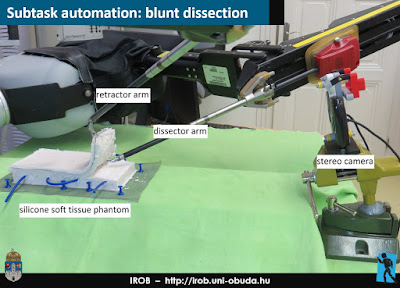Ontology-Based Surgical Subtask Automation, Automating Blunt Dissection
Our most recent article appreared in JMRR Special Issue on Continuum, Compliant, Cognitive, and Collaborative Surgical Robots; titled:
Abstract:
Automation of surgical processes (SPs) is an utterly complex, yet highly demanded feature by medical experts. Currently, surgical tools with advanced sensory and diagnostic capabilities are only available. A major criticism towards the newly developed instruments that they are not fitting into the existing medical workflow often creating more annoyance than benefit for the surgeon. The first step in achieving streamlined integration of computer technologies is gaining a better understanding of the SP. Surgical ontologies provide a generic platform for describing elements of the surgical procedures. Surgical Process Models (SPMs) built on top of these ontologies have the potential to accurately represent the surgical workflow. SPMs provide the opportunity to use ontological terms as the basis of automation, allowing the developed algorithm to easily integrate into the surgical workflow, and to apply the automated SPMs wherever the linked ontological term appears in the workflow. In this work, as an example to this concept, the subtask level ontological term “blunt dissection” was targeted for automation. We implemented a computer vision-driven approach to demonstrate that automation on this task level is feasible. The algorithm was tested on an experimental silicone phantom as well as in several ex vivo environments. The implementation used the da Vinci surgical robot, controlled via the Da Vinci Research Kit (DVRK), relying on a shared code-base among the DVRK institutions. It is believed that developing and linking further building blocks of lower level surgical subtasks could lead to the introduction of automated soft tissue surgery. In the future, the building blocks could be individually unit tested, leading to incremental automation of the domain. This framework could potentially standardize surgical performance, eventually improving patient outcomes.



Comments